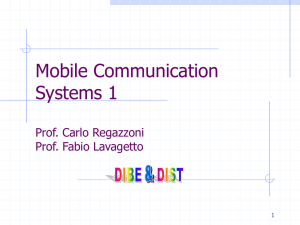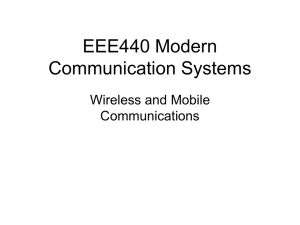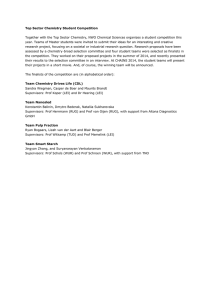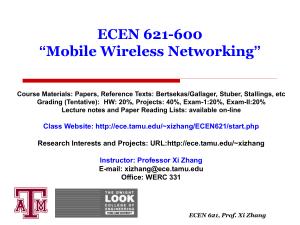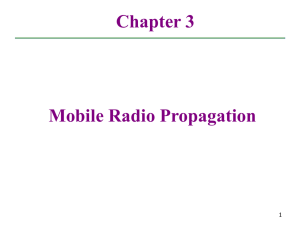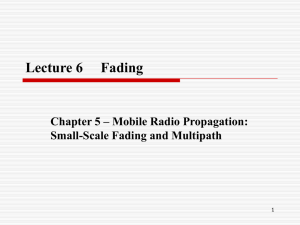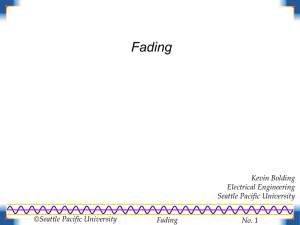Lecturing Notes 7
advertisement
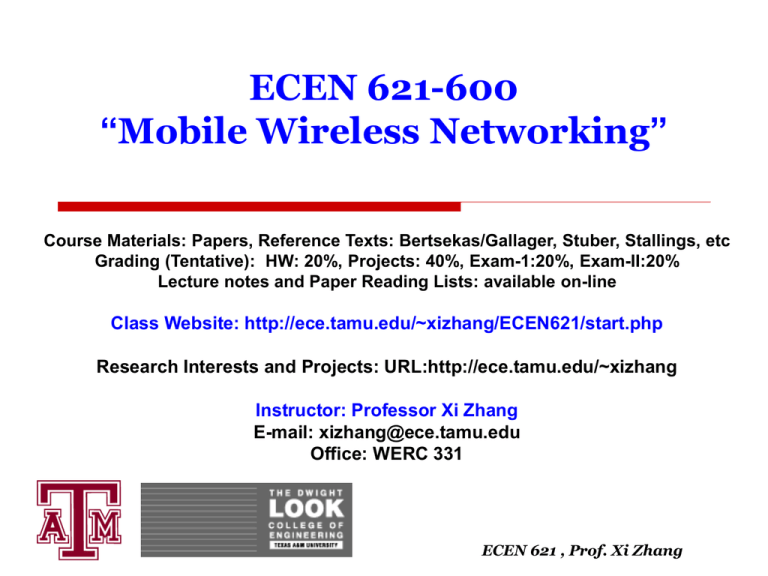
ECEN 621-600 “Mobile Wireless Networking” Course Materials: Papers, Reference Texts: Bertsekas/Gallager, Stuber, Stallings, etc Grading (Tentative): HW: 20%, Projects: 40%, Exam-1:20%, Exam-II:20% Lecture notes and Paper Reading Lists: available on-line Class Website: http://ece.tamu.edu/~xizhang/ECEN621/start.php Research Interests and Projects: URL:http://ece.tamu.edu/~xizhang Instructor: Professor Xi Zhang E-mail: xizhang@ece.tamu.edu Office: WERC 331 ECEN 621 , Prof. Xi Zhang Characterizations and Modeling of the Wireless Channel Lecture Notes 7. ECEN 621 , Prof. Xi Zhang Wireless channel disturbances Additive noise, like thermal background noise Multiplicative noise Distortion due to time dispersion Corruptive elements are in the forms of: Multipath delay spread Doppler spread due to motion Signal fading of frequency-selective and nonfrequency-selective variety Prof. Xi Zhang Multipath propagation environment Wireless propagation channel contains objects (particles) randomly scattering the energy of transmitted signals Scattered signals arrive at receiver out of step These objects (particles) are called scatterers Scatterers introduce: Fading Multipath delay spread Doppler spread Attenuation Prof. Xi Zhang Multipath delay spread Scattering by randomly located scatterers gives rise to different paths with different path-lengths/propagation-delays, resulting in multipath delay spread If the propagation channel doesn’t exhibit multipath delay spread, a point source (a single tone sinusoid) appears at front end of receiver as another point source A multipath situation arises when a transmitted point source is received as multipoint source, with each of individually received points experiencing a different transmission delay The effect of multipath propagation on digital transmission can be characterized by time dispersion and fading Prof. Xi Zhang Wireless channel time dispersion The transmitted point source will be received as a smeared wave due to multipath delay spread Non-overlapping scatterers give rise to distinct multi paths – characterized by their locations in scattering medium. All scatterers are located on ellipses with transmitter (Tx) and receiver (Rx) as the foci. One ellipse is associated with one path length/delay Signals reflected by scatterers located on the same ellipse experience the same propagation delay and thus signal components from these multi-paths are indistinguishable at the receiver Signals that are reflected by scatterers located on different ellipses arrive a the receiver with different delays Prof. Xi Zhang Ellipsoidal portrayal of scatterer location Prof. Xi Zhang Flat fading vs. frequency-selective fading and ISI If max difference in delay spread is small compared with symbol duration of transmitted signal, channel is said to exhibit flat fading If difference in delay spread is large compared with the symbol duration of transmitted signal, the channel exhibits frequency-selective fading In time domain, received signals corresponding to successive transmitted symbols through frequency-selective fading channel will overlap, giving rise to a phenomenon called inter-symbol interference (ISI) ISI is a signal-dependent distortion The severity of ISI increase with the width of delay spread. ISI distortion in time domain can also be examined in frequency domain ISI degrades transmission performance, which can be overcome by the channel equalization techniques Prof. Xi Zhang Background noise and AWGN Inherent background noise can be approximated as thermal noise and treated as Additive White Gaussian (AWGN) Digital transmission over practical wireless channels is mainly limited by interference or distortion other than AWGN Prof. Xi Zhang Wireless channel fading The multipath components can affect the received signal strength constructively or destructively, depending on carrier frequency and delay differences among the multi paths As a mobile station moves, the position of each scatterer w.r.t. transmitter and receiver may change The overall effect caused by multipath delay spread, Doppler spread, attenuation, thermal noise, etc. is that the received signal level fluctuates with time, which is the phenomenon called fading Prof. Xi Zhang Line-of-Sight (LOS) vs. non-line-of-sight (NLOS) The delay of Line-of-Sight (LOS) or direct path is the shortest path among the multi paths, having smallest propagation delay (often assumed to be zero); the delay of non-line-of-sight (NLOS) or reflected path has longer propagation delay. Prof. Xi Zhang Multipath propagation & LOS Prof. Xi Zhang An example of two-path channel Consider transmitting a single-tone sinusoid signal: Prof. Xi Zhang A wireless channel model with two propagation paths Prof. Xi Zhang Amplitude fluctuation of the two-path channel Prof. Xi Zhang Wireless channel fading analysis When mobile station moves, alpha_1, alpha_2, and tau change with time and thus received signal amplitude and phase also change with time. Assuming alpha_1 = 2 and alpha_2 = 1 Assuming alpha_1 = 1.1 and alpha_2 = 1.0, resulting in deeper fading Prof. Xi Zhang Effects of channel fading When signal components from two paths add destructively, transmitted signal experiences deep fading with a small value of the amplitude alpha During each deep fading, the instantaneously received signal power is very low, resulting in poor transmission quality (high transmission error rate) Diversity and error-correction coding are effective to combat channel fading for better transmission accuracy Channel fading is classified long-term fading or short-term fading: Short-term fading is rapid fluctuations caused by the local multipath (e.g., Rayleigh fading) Long-term fading is long-term slow variation in the mean level of received signal strength (e.g., Lognormal fading) caused by movement over large enough distance Multipath propagation in wireless mobile environment yields fading dispersive channel Signal propagation environment changes as the mobile station moves and /or as any surrounding scatterers move the wireless channel is time-varying and can be modeled as a linear time-variant (LTV) system Prof. Xi Zhang Linear time-variant (LTV) channel model Prof. Xi Zhang Input/output model of Wireless Channel Linear time-invariant (LTI) channel model —Review “Channel impulse response” Prof. Xi Zhang Input/output model of Wireless Channel Linear time-variant (LTV) channel Prof. Xi Zhang



